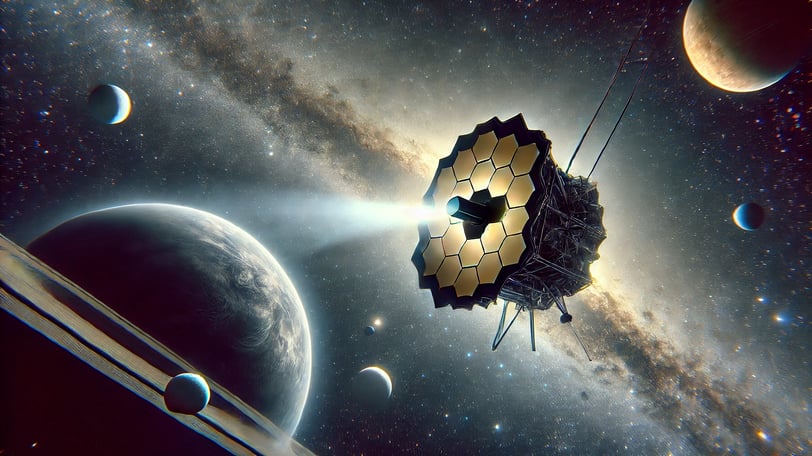James Webb Space Telescope: New Discoveries Revolutionizing Astronomy
Since its deployment in space, the James Webb Space Telescope (JWST) has been transforming our understanding of the universe. With its infrared observation capabilities, it has revealed unprecedented details about primordial galaxies, exoplanets, and stellar formation processes. Over the past two years, the telescope has brought to light impressive discoveries, including the recent identification of a colossal object wandering freely through the Milky Way and advances in understanding planetary formation and galaxy evolution.
3/7/20252 min read


Discovery of a Giant Object Roaming the Milky Way
In 2025, the JWST detected an object of remarkable proportions moving freely through the galaxy. This celestial body, with a mass between five and ten times that of Jupiter, is classified as a "rogue planet," a type of object that is not gravitationally bound to a star. The discovery was made during the analysis of a young star cluster, revealing that these planets may be more common than previously thought.
The JWST allowed scientists to study the atmospheric composition of the rogue planet in detail, suggesting the presence of silicate clouds and chemical elements similar to those found in the giant gas planets of the Solar System. The existence of this object challenges current planetary formation theories, indicating that these bodies may arise from multiple processes, such as ejection from a star system or the independent collapse of a gas cloud.
JWST Scientific Advances in 2024
Primordial Galaxies and the Formation of the Milky Way
In 2024, the JWST identified a young galaxy nicknamed "Firefly Sparkle," one of the oldest ever observed. Formed approximately 600 million years after the Big Bang, this galaxy has about 10 million solar masses and reveals details about how the Milky Way may have developed. This discovery was made possible thanks to the gravitational lensing effect, which magnified the galaxy’s light, allowing for detailed observations.
Carbon Dioxide on Charon
Another remarkable discovery in 2024 was the detection of carbon dioxide on the icy surface of Charon, Pluto’s largest moon. Scientists also identified the presence of hydrogen peroxide, suggesting that Charon's surface is affected by ultraviolet radiation and the solar wind. This observation provides crucial information about the chemical evolution of celestial bodies located at the outer edges of the Solar System.
Revising Planetary Formation Theories
JWST observations have also led to a revision of theories on planetary formation around ancient stars. Traditionally, it was believed that protoplanetary disks disappeared quickly, limiting the time available for planet formation. However, new images indicated the existence of dust disks around stars that are billions of years old, suggesting that planetary formation can occur over a much longer period than previously thought.
The Most Distant Known Galaxy
In 2024, the JWST was instrumental in identifying the most distant galaxy ever recorded, located just 290 million years after the Big Bang. This discovery is a milestone in understanding cosmic evolution and may provide valuable insights into the earliest structures formed in the universe.
Conclusion
The James Webb Space Telescope continues to push the boundaries of human knowledge, challenging established concepts and providing a new perspective on the cosmos. The discoveries of 2024 and 2025 not only offer clues about the universe’s past but also raise fundamental questions about its future. With the JWST in operation, space exploration is just beginning, and many new revelations are yet to come.
Explore
Discover diverse topics in one convenient hub.
Connect
Learn
contact@mindstormblog.com
© 2025. All rights reserved.


